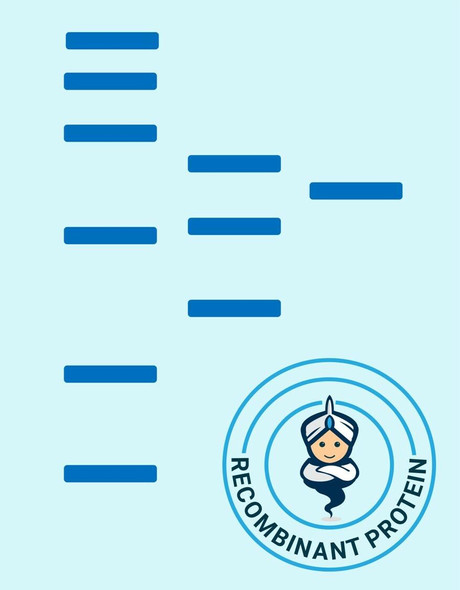Description
| Product Name: | Human GNAI3 Recombinant Protein |
| Product Code: | RPPB3615 |
| Size: | 10µg |
| Species: | Human |
| Target: | GNAI3 |
| Synonyms: | Guanine nucleotide binding protein (G protein) alpha inhibiting activity polypeptide 3, G(i) alpha-3, 87U6. |
| Source: | Escherichia Coli |
| Physical Appearance: | Sterile Filtered colorless solution. |
| Formulation: | The GNAI3 solution (0.5mg/1ml) contains 20mM Tris-HCl buffer (pH 8.0), 0.1M NaCl, 2mM DTT and 20% glycerol. |
| Stability: | Store at 4°C if entire vial will be used within 2-4 weeks. Store, frozen at -20°C for longer periods of time. For long term storage it is recommended to add a carrier protein (0.1% HSA or BSA).Avoid multiple freeze-thaw cycles. |
| Purity: | Greater than 90% as determined by SDS-PAGE. |
| Amino Acid Sequence: | MGSSHHHHHH SSGLVPRGSH MGSMGCTLSA EDKAAVERSK MIDRNLREDG EKAAKEVKLL LLGAGESGKS TIVKQMKIIH EDGYSEDECK QYKVVVYSNT IQSIIAIIRA MGRLKIDFGE AARADDARQL FVLAGSAEEG VMTPELAGVI KRLWRDGGVQ ACFSRSREYQ LNDSASYYLN DLDRISQSNY IPTQQDVLRT RVKTTGIVET HFTFKDLYFK MFDVGGQRSE RKKWIHCFEG VTAIIFCVAL SDYDLVLAED EEMNRMHESM KLFDSICNNK WFTETSIILF LNKKDLFEEK IKRSPLTICY PEYTGSNTYE EAAAYIQCQF EDLNRRKDTK EIYTHFTCAT DTKNVQFVFD AVTDVIIKNN LKECGLY |
GNAI3 is a member of the G-alpha family and G (i/o/t/z) subfamily which act as modulators or transducers in several transmembrane signaling systems. G(k) is the stimulatory G protein of receptor-regulated K+ channels. The active GTP-bound form inhibits the connotation of RGS14 with centrosomes and is essential for the translocation of RGS14 from the cytoplasm to the plasma membrane. GNAI3 takes part in cell division and is known to cooperate with RIC8A, S1PR1, RGS5, RGS10, RGS12, RGS14, RGS16, RGS18, and RGS19.
GNAI3 Human Recombinant produced in E. coli is a single polypeptide chain containing 377 amino acids (1-354) and having a molecular mass of 43.0kDa.GNAI3 is fused to a 23 amino acid His-tag at N-terminus & purified by proprietary chromatographic techniques.
| UniProt Protein Function: | G-alpha i3: Guanine nucleotide-binding proteins (G proteins) are involved as modulators or transducers in various transmembrane signaling systems. G(k) is the stimulatory G protein of receptor- regulated K(+) channels. The active GTP-bound form prevents the association of RGS14 with centrosomes and is required for the translocation of RGS14 from the cytoplasm to the plasma membrane. May play a role in cell division. Defects in GNAI3 are the cause of auriculocondylar syndrome 1 (ARCND1). ARCND1 is an autosomal dominant craniofacial malformation syndrome characterized by variable mandibular anomalies, including mild to severe micrognathia, temporomandibular joint ankylosis, cleft palate, and a characteristic ear malformation that consists of separation of the lobule from the external ear, giving the appearance of a question mark (question-mark ear). Other frequently described features include prominent cheeks, cupped and posteriorly rotated ears, preauricular tags, and microstomia. Belongs to the G-alpha family. G(i/o/t/z) subfamily. |
| UniProt Protein Details: | Protein type:G protein; G protein, heterotrimeric alpha G((i/o/t/z)); G protein, heterotrimeric Chromosomal Location of Human Ortholog: 1p13 Cellular Component: centrosome; cytoplasm; heterotrimeric G-protein complex; lysosomal membrane; membrane; midbody; plasma membrane Molecular Function:G-protein beta/gamma-subunit binding; G-protein-coupled receptor binding; GDP binding; GTP binding; GTPase activity; protein binding; signal transducer activity Biological Process: cell division; dopamine receptor signaling pathway; G-protein signaling, adenylate cyclase inhibiting pathway; GTP metabolic process; negative regulation of adenylate cyclase activity; protein folding Disease: Auriculocondylar Syndrome 1 |
| NCBI Summary: | Guanine nucleotide-binding proteins (G proteins) are involved as modulators or transducers in various transmembrane signaling pathways. G proteins are composed of 3 units: alpha, beta and gamma. This gene encodes an alpha subunit and belongs to the G-alpha family. Mutation in this gene, resulting in a gly40-to-arg substitution, is associated with auriculocondylar syndrome, and shown to affect downstream targets in the G protein-coupled endothelin receptor pathway. [provided by RefSeq, Jun 2012] |
| UniProt Code: | P08754 |
| NCBI GenInfo Identifier: | 120996 |
| NCBI Gene ID: | 2773 |
| NCBI Accession: | P08754.3 |
| UniProt Secondary Accession: | P08754,P17539, Q5TZX1, |
| UniProt Related Accession: | P08754 |
| Molecular Weight: | 40,532 Da |
| NCBI Full Name: | Guanine nucleotide-binding protein G(k) subunit alpha |
| NCBI Synonym Full Names: | G protein subunit alpha i3 |
| NCBI Official Symbol: | GNAI3�� |
| NCBI Official Synonym Symbols: | 87U6; ARCND1�� |
| NCBI Protein Information: | guanine nucleotide-binding protein G(k) subunit alpha |
| UniProt Protein Name: | Guanine nucleotide-binding protein G(k) subunit alpha |
| UniProt Synonym Protein Names: | G(i) alpha-3 |
| UniProt Gene Name: | GNAI3�� |
| UniProt Entry Name: | GNAI3_HUMAN |






